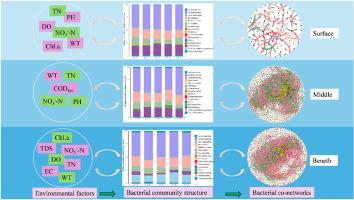微生物聚集与网络稳定性:丹江口水库细菌敏感性响应高于真核生物和真菌
IF 8.4
2区 环境科学与生态学
Q1 ENVIRONMENTAL SCIENCES
引用次数: 0
摘要
水深变化会引起水库微生物群落垂直结构的变化,进而影响微生物群落沿深度梯度的关系,深刻影响水生生态系统的稳定性。然而,深水低营养饮用水水库不同水层微生物群落的种间动态尚不清楚。因此,我们在本研究中评估了不同水层微生物群落的动态变化。对2022年7月至2023年8月丹江口水库表层、中层和底层的理化参数及不同浮游微生物进行了研究。基于高通量测序技术、模型分析和网络分析,研究了不同水层微生物群落的多样性、群落建设过程和共生网络差异。结果表明:丹江口水库不同水深细菌群落多样性显著高于真菌和真核微生物。不同水深细菌群落的优势类群为放线菌门、拟杆菌门、变形菌门和蓝藻门。优势门为子囊菌门、未分类真菌门和壶菌门。真核生物群落垂直优势种的相对丰度略有差异,包括隐藻、绿藻、甲藻和后生动物。不同微生物群落在垂直分层上具有共同的主要优势种。中性模型表明,随机过程显著影响不同水层微生物群落的组装过程,真菌群落的迁移率远低于细菌和真核生物。共现网络分析显示,细菌群落的节点数和边缘数最多,说明该细菌群落的网络规模最大。此外,地表水中细菌和真核生物群落的图谱密度和平均聚类系数最高,表明地表微生物物种具有较高的连通性,能够更好地传递物质和交换信息,对外部环境变化敏感。相比之下,在真菌群落中,微生物的相互作用在底部是最复杂的。不同水深微生物群落间的相互作用以正相关为主,中、底水微生物群落间的负相关大于地表水,表明物种间的竞争随着水深的增加而加剧。相关分析表明,关键微生物群落种类与TP、PO43—P、NO3−-N和ORP呈显著相关。综上所述,通过分析水深变化对丹江口水库微生物群落空间分布格局、群落组装过程和共生网络稳定性的影响,我们发现细菌群落对水深的敏感性高于真核生物和真菌。本研究揭示了低营养水库微生物群落对水深的响应机制,有助于反映水生态过程,为后续水库生态模型的构建提供理论依据。本文章由计算机程序翻译,如有差异,请以英文原文为准。

Cross-sectional-dependent microbial assembly and network stability: Bacteria sensitivity response was higher than eukaryotes and fungi in the Danjiangkou Reservoir
Water depth variation can lead to the vertical structure change of microbial communities in reservoirs, and then affect the relationship between the microbial communities along the depth gradient, profoundly affecting the stability of the aquatic ecosystems. However, the interspecific dynamics of microbial communities across different water layers in deep-water low-nutrient drinking water reservoirs remain not well understood. Thus, we assessed microbial communities' dynamic changes in different water layers in this study. The physical and chemical parameters and different planktonic microbial of the surface, middle, and bottom layers were studied from July 2022 to August 2023 in the Danjiangkou Reservoir, China. Based on high-throughput sequencing technology, model analysis and network analysis, the diversity of microbial communities in different water layers, community construction process and co-occurrence network differences were studied. The results showed that the diversity of bacterial communities in the Danjiangkou reservoir was significantly higher than that of fungi and eukaryotic microorganisms in different water depths. The dominant taxa of the bacterial communities in different water depths were Actinobacteriota, Bacteroidota, Proteobacteria and Cyanobacteria. The dominant phyla were Ascomycota, unclassified_k__Fungi and Chytridiomycota. The relative abundance of vertical dominant species in eukaryotic communities was slightly different, including Cryptophyta, Chlorophyta, Dinophyta and Metazoa. Different microbial communities shared the main dominant species on the vertical stratification. The neutral model showed that random processes significantly affected the assembly process of microbial communities in different water layers, and the mobility of fungal communities was much lower than that of bacteria and eukaryotes. The co-occurrence network analysis showed that the number of nodes and edges of the bacterial community was the highest, indicating that the network scale of the bacterial community was the largest. In addition, the map density and average clustering coefficient of bacterial and eukaryotic communities in surface water were the highest, indicating that the surface microbial species had a high degree of connectivity, can better transfer materials and exchange information, and Sensitive to changes in the external environment. In contrast, in fungal communities, microbial interactions were the most complex at the bottom. The interactions between microbial communities in different water depths were mainly positive, and the negative correlation of microbial communities in the middle and bottom water was greater than that in the surface water, indicating that the competition between species increased with the increase of depth. Correlation analysis showed that the key species of microbial community were significantly correlated with TP, PO43--P, NO3−-N and ORP. In summary, by analyzing water depth changes’ impacts on the spatial distribution pattern, community assembly process and symbiotic network stability of microbial communities in the Danjiangkou Reservoir, we found that bacterial communities were more sensitive to water depth than eukaryotes and fungi. This study revealed the response mechanism of microbial communities to water depth in low-nutrient reservoirs, which is helpful to reflect aquatic ecological processes and provide a theoretical basis for the construction of subsequent reservoir ecological models.
求助全文
通过发布文献求助,成功后即可免费获取论文全文。
去求助
来源期刊

Journal of Environmental Management
环境科学-环境科学
CiteScore
13.70
自引率
5.70%
发文量
2477
审稿时长
84 days
期刊介绍:
The Journal of Environmental Management is a journal for the publication of peer reviewed, original research for all aspects of management and the managed use of the environment, both natural and man-made.Critical review articles are also welcome; submission of these is strongly encouraged.
 求助内容:
求助内容: 应助结果提醒方式:
应助结果提醒方式:


